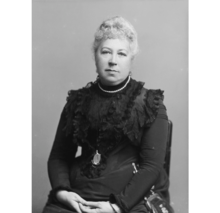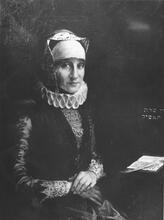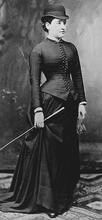Jewish Association for the Protection of Girls and Women
The Jewish Association for the Protection of Girls and Women (JAPGW) was an Anglo-Jewish anti-sex trafficking organization founded at the end of the nineteenth century by Constance Rothschild, Lady Battersea. The JAPGW took a multifaceted approach to aiding young Jewish immigrant women who had been or were at risk of being forced into prostitution. It aided newly arrived women at the ports, founded boarding homes for at-risk women, and provided occupational training. The JAPGW, which lasted until after the Second World War, eventually involved some of the most prominent Anglo-Jewish families and British Parliamentarians and collaborated with the League of Nations after the First World War to combat the sex trade.
The Jewish Association for the Protection of Girls and Women (JAPGW) was a British organization dedicated to preventing sex trafficking and prostitution among the poor immigrant Jewish community of Britain. Founded by Constance Rothschild Battersea in 1885, the organization was active until 1947 and maintained strong ties to prominent Anglo-Jewish families, including both the Rothschilds and the Montefiores.
Founding
At the time of its founding, the JAPGW was the first British Jewish organization to tackle a controversial issue. Prostitution was endemic in London at the end of the nineteenth century, and a syphilis epidemic had made the issue a pressing public health concern. Poor women and immigrants were especially vulnerable to recruitment into the sex trade, either willingly or coercively. However, the Jewish community in Britain, particularly at the higher levels of Anglo-Jewish society, was reluctant to publicly admit that Jewish prostitution existed at all, let alone to begin to combat it. In reality, both Jewish prostitutes and Jewish traffickers existed, although the extent of both has been disputed and remains difficult to determine. London, where the JAPGW was initially based, was often a way station for sex traffickers, themselves from a variety of nationalities, whose aim was to transport unwitting young women (often under the pretense of a romantic involvement and engagement to the trafficker, or reputable employment abroad) from Eastern Europe to South America, most commonly Argentina, to be sold into prostitution.
To the extent Anglo-Jewish community at the end of the nineteenth century was aware of this problem, it was hesitant to address it, particularly as there was a common tendency among persons of all faiths and backgrounds at the time to paint victimized women as morally bankrupt. To publicly acknowledge Jewish prostitution was seen by some as tantamount to publicly acknowledging the broader Jewish community as morally deficient. Further, with the wave of mass immigration to Britain that began at the end of the nineteenth century, many established British Jews were hesitant to associate themselves with newly blossoming racialized stereotypes of Jewish criminality, which, by the 1880s had already spawned various anti-Semitic anti-immigrant movements.
Against this uneasy backdrop entered Constance, Lady Battersea, a member of the extremely influential Rothschild family whose powerful position had been further enhanced by her marriage to Cyril Flower, Lord Battersea. Following consultation with her cousin and close friend Annie de Rothschild, Battersea endeavored to use her extensive social connections to found an organization to aid young Jewish immigrant women who had been or were at risk of being taken advantage of by sex traffickers in London’s East End. The organization was initially known as the Jewish Ladies’ Society for Preventative and Rescue Work (“rescue work” was a common late Victorian euphemism for aid to women in prostitution), but it would later be known and rise to prominence as the Jewish Association for the Protection of Girls and Women.
Anglo-Jewish Prominence
The JAPGW had socially prestigious origins from the beginning. In her personal diaries, Constance, Lady Battersea describes how she initially founded the organization, broaching the subject at dinners and social gatherings at the homes of London’s Anglo-Jewish elite and her husband’s gentile political acquaintances. She also built on her ties to the already well-established Jewish Ladies’ Association, which some consider a predecessor to the JAPGW. In her memoirs, Lady Battersea also described how she felt the organization served a specific need, after hearing of two Jewish prostitutes who were unable to find any refuge not explicitly tied to Christian religious organizations.
The organization began as a small circle of wealthy Anglo-Jewish women, with Lady Battersea and her cousin, Emma de Rothschild, taking the lead. The organization soon included a “gentlemen’s committee,” headed by eventual organization chairman and founding father of Liberal Judaism Claude Montefiore, which supervised the direct work with newly arrived immigrant women at the ports. (At the time, the environments of the ports where immigrants were arriving was considered too dangerous for the ladies of the Association; one purpose of the gentlemens’ auxiliary was to do physical aid work considered unsuitable for women.) This work included offering aid to women immigrating alone, who often fell prey to offers of lodging or employment that proved to be covers for sex trafficking. The JAPGW instead assisted these women in making contact with friends or relatives in London, or with legitimate boarding establishments, including those run by the Association itself.
Direct Aid and Public Relations
The JAPGW took a multifaceted approach to aid. It founded homes (the earliest, Charcroft House, would eventually become a maternity homefor imporverished unwed mothers), as well as training facilities at Highbury Home and Montefiore House where women wishing to leave prostitution could be housed and taught skills in order to qualify for employment in domestic service. The nature of this “rescue work” built on late Victorian notions about the redemptive power of employment, as well as the so-called “servant crisis” of the late nineteenth century, when demand for domestic help vastly outstripped supply.
A legal arm was headed by solicitor and Association member Arthur R. Moro, whose practice centered around combating sex trafficking. It also published an annual report detailing not only its own activities, but also the general state of sex trafficking within Britain’s Jewish community, and recommending courses of action; the reports included tables, numbers, and figures on immigration, ships arriving in Britain, “unprotected girls” arriving on each ship, and related data. The reports were in keeping with the late nineteenth-century trend towards a scientific approach to social work, with an extensive focus on data as opposed to a reliance on emotional appeals or individual case studies. JAPGW rhetoric also leaned heavily on the Victorian language of “social hygiene” and the importance of “redemption” for those who had strayed from it.
Although founded and based in London, by the first decade of the twentieth century, the JAPGW considered itself an international organization(it convened a dinner described as a “Jewish International Conference” in London in 1910). These aspirations to broader recognition were due not only to altruistic concerns, but also to the social prominence of its founding members and chief supporters. The Association had been founded both out of a moral desire to help trafficking victims and a desire by prominent British Jews to counter stereotypes of Jewish criminality and vice through a testimonial-bearing organization of unquestionable moral virtue. Expanding the organization to international recognition not only expanded the range of people they could help, but also the scale of their influence and moral standard-bearing. And indeed the organization did blossom into a truly international one: by 1926, the JAPGW had volunteer emissaries posted at ports of entry across Europe and South America, issuing warnings and offers of aid to any women who might have been traveling under false pretexts.
Broader Connections
Although always a Jewish organization in both name and spirit, the JAPGW from the first understood the importance of mobilizing non-Jews interested in the cause, including members of parliament, many of whom were already familiar with Lady Battersea, in particular through her husband, Cyril Flower. It also promoted anti-trafficking bills, including the so-called White Slave Traffic Bill of 1912, part of the greater Edwardian moral panic around so-called “white slavery,” or sex trafficking. Although the JAPGW heavily supported it, the bill became controversial among Anglo-Jewry, as it was used to explicitly target Jews as agents of vice while falsely claiming that trafficking victims were English gentiles. The JAPGW published literature in 1922 “exposing anti-Semitic lies” and contradicting this message, while celebrating its role in passing the bill, claiming that the organization, and the broader awareness it raised amongst Jewish volunteers, had heroically stopped foreign trafficking of prostitutes. The JAPGW also worked with the League of Nations in tracking cases of international sex trafficking after the First World War; the League of Nations tracked cases by the origins and heritage of all parties involved, and the JAPGW was pleased to note the declining number of Jewish cases.
The dwindling instances of Jewish involvement in sex trafficking, as well as the more pressing matters regarding Jewish refugees following the Second World War, eventually led to the dismantling of the JAPGW in the 1940s. The JAPGW would take some credit for the lowering numbers of Jews involved in trafficking, but other relevant factors included growing awareness of potential traffickers in small towns in Eastern Europe, the greater crackdown against prostitution in the Edwardian era, and the general ebb of the great early-twentieth-century immigration wave following the First World War. However, the legacy of the JAPGW, both as an organization in itself and as an example of Jewish involvement in the late Victorian era’s distinct flavor of charitable action, remains to this day.
Gartner, Lloyd P. “Anglo-Jewry and the Jewish International Traffic In Prostitution” AJS Review (Jan. 1982) Vol. 7/8, pp. 129-178.
Ivry, Sarah. “In the Life.” Washington Jewish Week (March 23, 2006) Vol. 42(12) p.N7.
Knepper, Paul. “British Jews and the Racialization of Crime in the Age of Empire.” The British Journal of Criminology (2007) Vol. 47 (1), pp. 61-79.
“Testimonial to Lord & Lady Rothschild from the Jewish Association for the Protection of Women and Girls” Published online at The Rothschild Archive Website: https://www.rothschildarchive.org/exhibitions/faith_charity/testimonial…
Tananbaum, Susan L. Jewish Immigrants in London, 1880-1939. Routledge, 2014.
With special thanks to The Rothschild Archive in the City of London.













